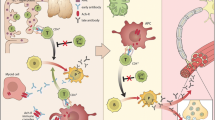Summary
Glycogen storage disease type Ib (GSD Ib, OMIM 232220) is an inborn disorder of glucose metabolism, caused by mutations in the G6PT gene, encoding a glucose 6-phosphate transporter (G6PT). GSD Ib is mainly associated with fasting hypoglycaemia and hepatomegaly. Most GSD Ib patients also show neutropenia and neutrophil dysfunction and therefore are at risk of develo** severe infections and inflammatory bowel disease (IBD). An increased risk for autoimmune disorders, such as thyroid autoimmunity and Crohn-like disease, has also been demonstrated, but no systematic study on the prevalence of autoimmune disorders in GSD Ib patients has ever been performed. We describe a 25-year-old patient affected by GSD Ib who developed ‘seronegative’ myasthenia gravis (MG), presenting with bilateral eyelid ptosis, diplopia, dysarthria, severe dysphagia, dyspnoea and fatigue. The repetitive stimulation of peripheral nerves test showed signs of exhaustion of neuromuscular transmission, particularly evident in the cranial area. Even in the absence of identifiable anti-acetylcholine receptor antibodies, seronegative MG is considered an autoimmune disorder and may be related to the disturbed immune function observed in GSD Ib patients.

Similar content being viewed by others
Abbreviations
- G6P:
-
glucose 6-phosphate
- G6Pase α:
-
glucose-6 phosphatase α
- G6PT:
-
glucose 6-phosphate transporter
- G-CSF:
-
granulocyte colony-stimulating factor
- GSD I:
-
glycogen storage disease type I
- MG:
-
myasthenia gravis
- NMJ:
-
neuromuscular junction
References
Burges J, Vincent A, Molenaar PC, et al (1994) Passive transfer of seronegative myasthenia gravis to mice. Muscle Nerve 17: 1393–1400.
Calderwood S, Kilpatrick L, Douglas SD, et al (2001) Recombinant human granulocyte colony-stimulating factor therapy for patients with neutropenia and/or neutrophil dysfunction secondary to glycogen storage disease type 1b. Blood 97: 376–382.
Chen YT (2001) Glycogen storage disease. In: Scriver CR, Beaudet AL, Sly WS, Valle D, eds; Childs B, Kinzler KW, Vogelstein B, assoc. eds. The Metabolic and Molecular Bases of Inherited Disease, 8th edn. New York: McGraw-Hill, 1521–1551.
Chou JY, Matern D, Mansfield BC, Chen YT (2002) Type I glycogen storage disease: disorders of the glucose-6-phosphatase complex. Curr Mol Med 2: 121–143.
Conti-Fine BM, Milani M, Kaminski HJ (2006) Myasthenia gravis: past, present, and future. J Clin Invest 116: 2843–2854.
Dieckgraefe BK, Korzenik JR, Husain A, Dieruf L (2002) Association of glycogen storage disease 1b and Crohn disease: results of a North American survey. Eur J Pediatr 161: S88–S92.
Evoli A, Batocchi AP, Lo Monaco M, et al (1996) Clinical heterogeneity of sieronegative myasthenia gravis. Neuromusc Disord 6: 155–161.
Folwaczny C, Glas J, Torok HP (2003) Crohn’s disease: an immunodeficiency? Eur J Gastroenterol Hepatol 15: 621–626.
Gajdos P (2004) Seronegative myasthenia gravis. [In French]. Rev Neurol (Paris) 160: 159–162.
Jaretzki A, Barhon RJ, Ernstoff RM, et al (2000) Myasthenia gravis: recommendations for clinical research standards. Task Force of the Medical Scientific Advisory Board of the Myasthenia Gravis Foundation of America. Neurology 55: 16–23.
Kim SY, Nguyen AD, Gao JL, et al (2006) Bone marrow-derived cells require a functional glucose 6-phosphate transporter for normal myeloid functions. J Biol Chem 281: 28794–28801.
Leuzzi R, Banhegyi G, Kardon T, et al (2003). Inhibition of microsomal glucose-6-phosphate transport in human neutrophils results in apoptosis: a potential explanation for neutrophil dysfunction in glycogen storage disease type 1b. Blood 101: 2381–2387.
Magistretti PJ, Allaman I (2007) Glycogen: a Trojan horse for neurons. Nat Neurosci 10: 1341–1342.
Meager A, Wadhwa M, Bird C, et al (1999) Spontaneously occurring neutralizing antibodies against granulocyte-macrophage colony-stimulating factor in patients with autoimmune disease. Immunology 97: 526–532.
Melis D, Parenti G, Della Casa R, et al (2003) Crohn’s-like ileo-colitis in patients affected by glycogen storage disease Ib: two years’ follow-up of patients with a wide spectrum of gastrointestinal signs. Acta Paediatrica 92: 1415–1421.
Melis D, Pivonello R, Parenti G et al (2007) Increased prevalance of thyroid autoimmunity and hypothyroidism in patients with glycogen storage disease type 1. J Pediatr 150: 300–305.
Ozen S, Ruperto N, Dillon MJ, et al (2006) EULAR/PReS endorsed consensus criteria for the classification of childhood vasculitides. Ann Rheum Dis 65: 936–941.
Romagnani S (1994) Lymphokine production by human T cells in disease states. Annu Rev Immunol 12: 227–257.
Sheng JR, Li L, Ganesh BB, Vasu C, et al (2006) Suppression of experimental autoimmune myasthenia gravis by granulocyte-macrophage colony-stimulating factor is associated with an expansion of FoxP3+ regulatory T cells. J Immunol 177: 5296–5306.
Sleasman JW (1996) The association between immunodeficiency and the development of autoimmune disease. Adv Dent Res 10: 57–61.
Visser G, Rake JP, Fernandes J, et al (2000) Neutropenia, neutophil dysfunction, and inflammatory bowel disease in glycogen storage disease type Ib: results of European Study on Glycogen Storage Disease type I. J Pediatr 137: 187–191.
Author information
Authors and Affiliations
Corresponding author
Additional information
Communicating editor: Matthias Baumgartner
Competing interests: None declared
References to electronic databases: glycogen storage disease type Ib: OMIM 232220.
Rights and permissions
About this article
Cite this article
Melis, D., Balivo, F., Della Casa, R. et al. Myasthenia gravis in a patient affected by glycogen storage disease type Ib: A further manifestation of an increased risk for autoimmune disorders?. J Inherit Metab Dis 31 (Suppl 2), 227–231 (2008). https://doi.org/10.1007/s10545-008-0810-4
Received:
Revised:
Accepted:
Published:
Issue Date:
DOI: https://doi.org/10.1007/s10545-008-0810-4




